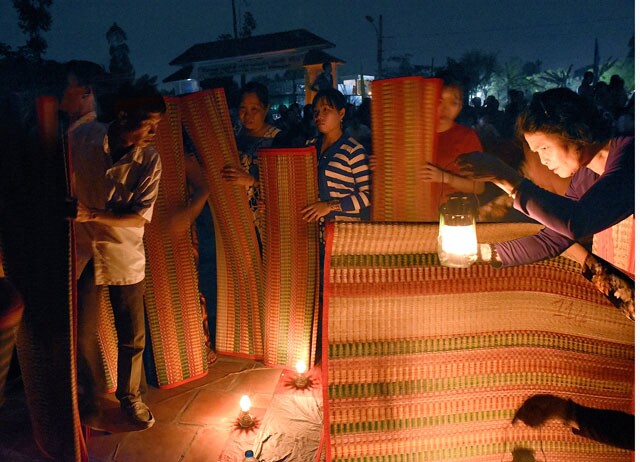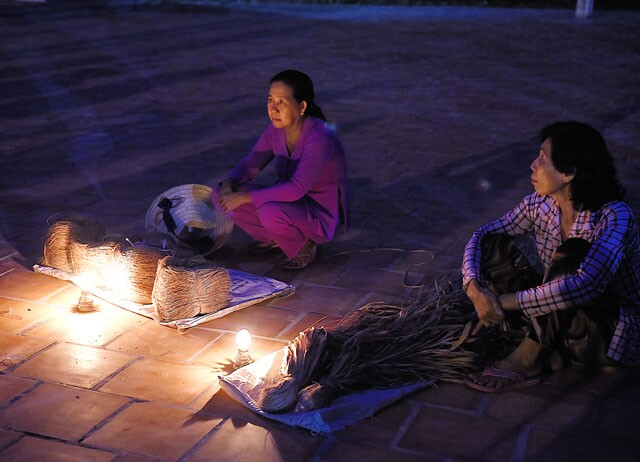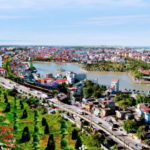With support from experts from Hoi An, Quang Nam, the People’s Committee of Lap Vo District, Dong Thap Province, organized a reenactment of the Dinh Yen “ghost market.” The “ghost market” took place at the Dinh Yen Communal House, with scenes depicted on the shore and in the canal under the Dinh Yen Bridge.
In the serene setting, accompanied by the sound of frogs, visitors were transported back in time to the ancient “ghost market.” Hundreds of people from all over gathered in front of the Dinh Yen Communal House to sell their mats. Here, buyers and sellers negotiated prices under the dim light of oil lamps and coconut leaf torches, creating vivid memories of the once-thriving market in Dinh Yen mat-weaving village.

According to some locals from Dinh Yen mat-weaving village, due to the habits and specific conditions of the mat-weaving profession, the market usually opened at night, from midnight to two or three in the morning, depending on the tide. In front of the Dinh Yen Communal House, traders and mat sellers would walk or row their boats to buy and sell mats and finished products, then take them elsewhere.
Elders in the village shared that the origin of the name “ghost market” stems from the quiet nights in the countryside. As people approached the market, the flickering light of oil lamps and coconut leaf torches created a mystical atmosphere. The dim glow of the lamps used for transactions further enhanced the illusion of ghosts wandering through the dark paths and canals, hence the name “ghost market.”
The reenactment of the Dinh Yen “ghost market” not only revived the image of the once-famous mat market but also helped promote the culture and people of Dong Thap to domestic and international tourists. This unique cultural aspect of Lap Vo and Dong Thap Province has survived and thrived for over a century.

The Dinh Yen “ghost market” is a source of pride for the traditional craft village in the province. Mat weaving has supported generations of families, and many locals have achieved success and contributed to their hometown thanks to the income generated from mat sales. Reenacting the “ghost market” not only elevates the centuries-old craft but also helps promote the image of the Land of Pink Lotus.
Dinh Yen mat-weaving village, located in Dinh Yen and Dinh An communes of Lap Vo District, Dong Thap Province, has a history of over a hundred years. It was recognized as a National Intangible Cultural Heritage by the Ministry of Culture, Sports, and Tourism in September 2013. Despite the ups and downs of history, the village has preserved its antique charm and invaluable historical value.

According to the mat-weaving artisans in Dinh Yen, the primary material for mat weaving is local sedge. However, due to the increasing production demands, the local supply of sedge is no longer sufficient, so villagers have to purchase sedge from neighboring areas.
In its heyday, the Dinh Yen mat-weaving village had over 3,000 households engaged in the craft. Today, this number has decreased to around 400 households, mainly in Dinh Yen and Dinh An communes. On average, the village supplies millions of mats to the market annually, offering a wide range of designs and sizes.

With modern machinery, each mat-weaving worker can produce approximately 10 to 12 mats per day. The selling price of a finished mat ranges from 50,000 to 70,000 VND, depending on the type and size.
Currently, Dinh Yen mat-weaving village owns 620 mat-weaving machines, 62 cover sewing machines, 2 thread-spinning machines, and 2 product polishing machines, serving 431 households engaged in mat weaving. Annually, the village produces and supplies over 1.3 million mats to the market, generating a total revenue of approximately 80 billion VND. This has provided stable jobs and income for nearly 3,800 households involved in production, trading, and related services.



































